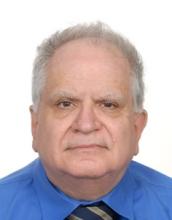Departments Seminar Program (Webinars) - Nick Vlachopoulos

Περίληψη
In recent years the interfacing of molecular solar cells, including dye-sensitised solar cells (DSSCs) and electrochemical energy storage cells, batteries or capacitors, has been attracting a considerable interest, with the respective hybrid systems termed as photobatteries and photocapacitors. After a brief introduction to the basic principles of DSSC operation and to the the useful and deleterious reactions at the photoelectrode, at first photobatteries will be discussed, of which two main types can be distinguished: these based solely on redox reactions in solution, usually with the necessity for external storage of the solutions, due to the low energy density of the electrolyte solutions, and these incorporating solid energy storage materials with high energy density, e.g., metals, metal oxides or electronically conducting polymers, in one of the electrodes. In addition to the most common three-electrode model, alternative two-electrode and four-electrode (two separate cells in series) systems will be presented. Subsequently, photocapacitors will be introduced. After a brief presentation of the basic concepts of electrochemical supercapacitor concepts and operation, the two basic types of photocapacitor, that of two and three-electrode, will be presented, with a discussion of the disadvantages of the first type, despite the construction simplicity, as compared to the second one. In the latter, light is harvested by a DSSC, based, as regards the charge-transport medium between photoelectrode and counter electrode, either on a liquid electrolyte containing a redox mediator or a solid hole conductor, juxtaposed to a capacitor based on carbon, metal oxide or conducting polymer electrodes. For both photobatteries and photocapacitors several systems will be discussed, with the various processes at and between the electrodes presented in detail.
Reference
N. Vlachopoulos and A. Hagfeldt, Photobatteries and Photocapacitors, in Molecular Devices for Solar Energy Conversion and Storage, H. Tian, G. Boschloo and A, Hagfeldt, Eds, Springer Nature Pte Ltd., Singapore 2008, pp. 281-325, https://doi.org/10.1007/978-981-10-5924-7_8.
Σύντομο Βιογραφικό Ομιλητή
Dr. Nick Vlachopoulos obtained a chemical engineering degree from the National Technical University of Athens, Greece (1979) and two doctorates from the University of Pennsylvania, Philadelphia, USA (1984) and the Swiss Federal Institute of Technology in Lausanne (EPFL), Switzerland (1990) in chemical engineering and physical chemistry, respectively. He worked as researcher in Professor Michael Grätzel's group in EPFL for several years (1986–99) in the area of photochemical solar energy conversion, and for shorter periods (1988-89, 2000-2014) in universities of France (on leave from EPFL), Denmark, Germany and Sweden in various areas of analytical and physical electrochemistry, and, as research and development scientist, in Ntera Inc., Dublin, Ireland, in electrochromic display technology from 2004–2007. In 2014 he returned as senior scientist to EPFL in the team of Professor Anders Hagfeldt, where, until his retirement in February 2021, he was involved in research related to the molecular electrochemistry of chemically-modified mesoscopic oxide electrodes and their application to solar energy, as well as in the teaching of physical chemistry and photoelectrochemistry. Actually, he is active in electrochemical research, as external collaborator in EPFL and the University of Grenoble as well as, as a part-time R&D scientist, in Corintis SA of Lausanne, Switzerland.